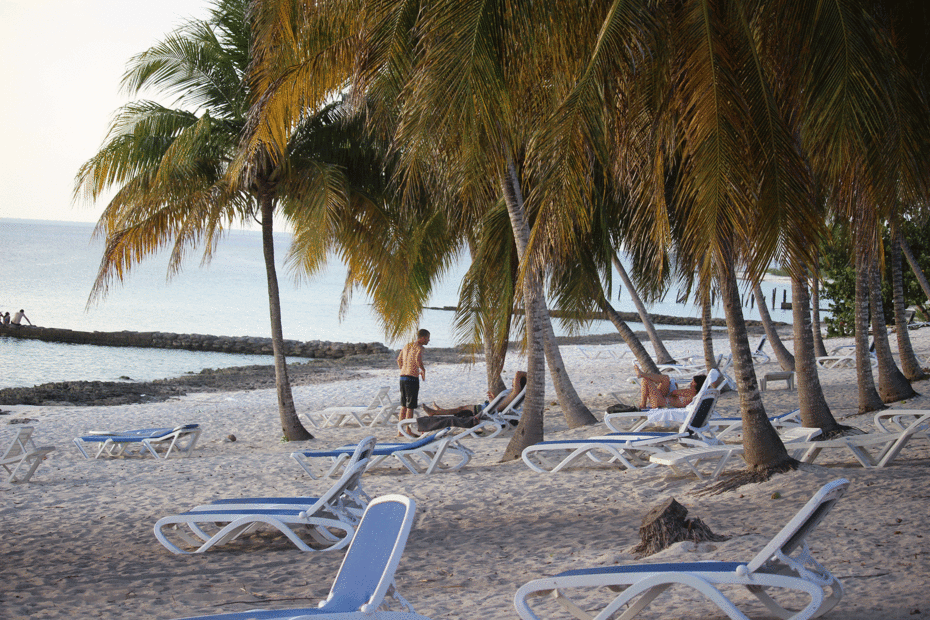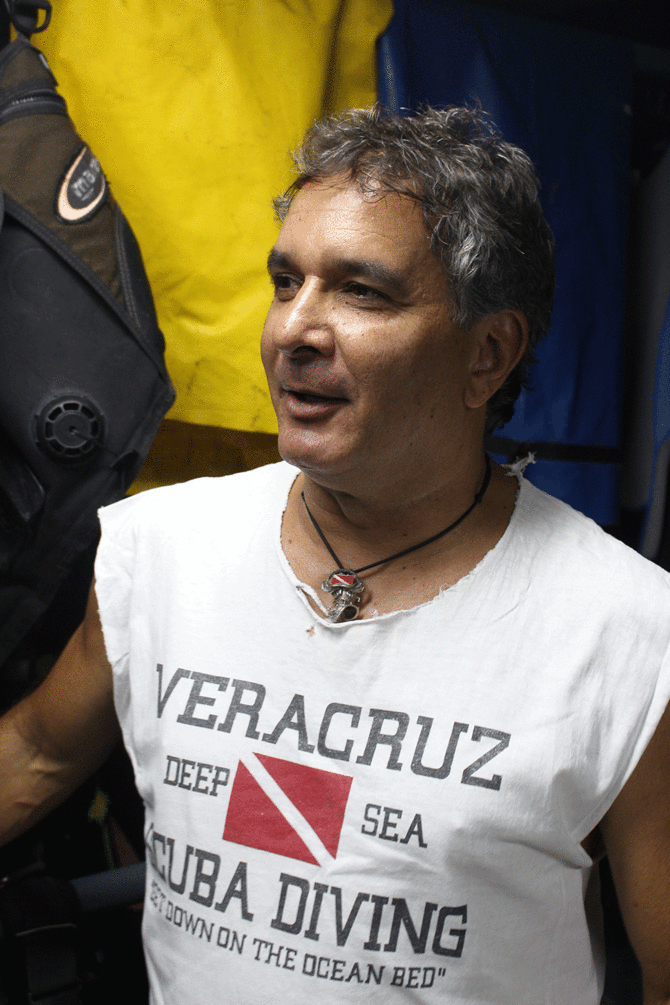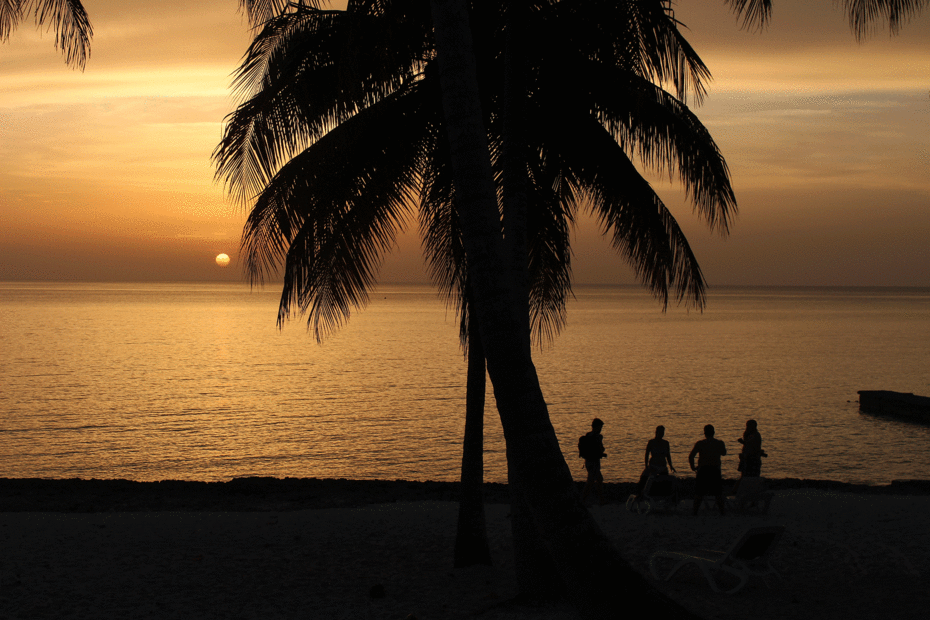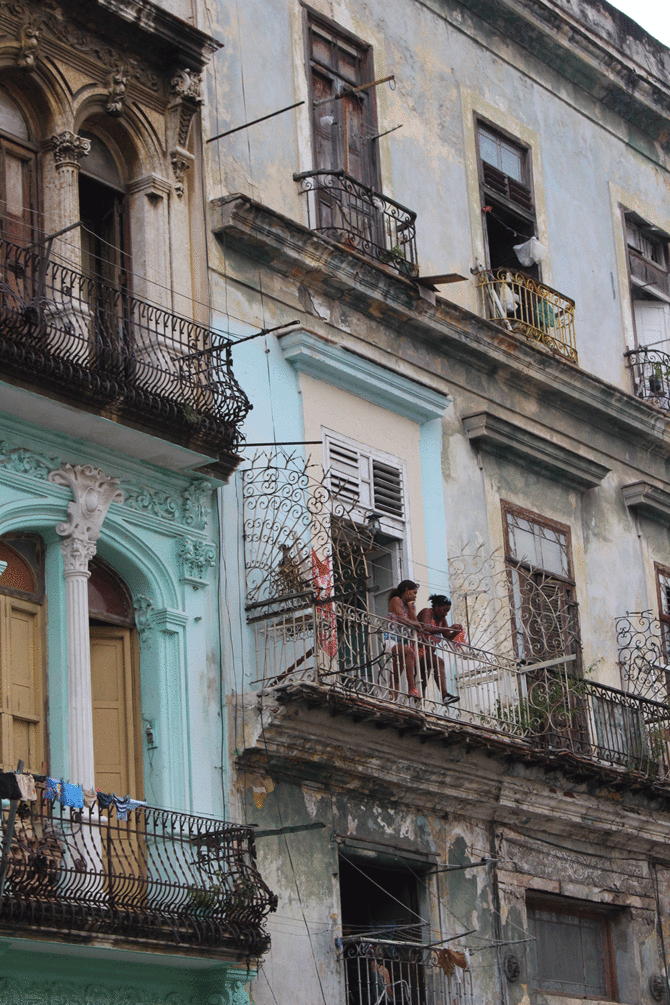 PHOTO: DOUG STRUCKMaría la Gorda is home to a thriving coral reef.
PHOTO: DOUG STRUCKMaría la Gorda is home to a thriving coral reef.For an American, getting to María la Gorda, a remote diving destination on the western tip of Cuba, isn’t easy. First, you must circumvent U.S. law and slip into Havana from a third country. Then you’re pretty much on your own.
After arriving in Havana through the Cayman Islands, I asked the tour desk in the foreigner-filled Hotel Nacional how to get there. The attendants simply shrugged. Surrounded by bus maps, they insisted there is no scheduled public transportation to María la Gorda, and no tour company serves it up. This left me with the option of paying a driver heading that way for what turned into a five-hour slog across 200 miles of Cuban countryside. Half the trip was spent on a ragged two-lane road, swerving and braking for horse carts, wandering goats, rickety bikes, sputtering motorcycles, and gaping holes. It is hazardous: The 1959 Chevy that had been coming up too fast behind us slammed its brakes and careened off the road. On the way back, the Jeep I had hired lost its clutch in a pothole.
Against these odds, María la Gorda is expecting a flood of tourists as the 55-year-old embargo that restricted U.S.–Cuban trade and prohibited Americans from traveling freely here eases up. The question is, How will this isolated spot—or any of the island’s other environmental treasures—handle the influx?
“Maybe soon, many more Americans will come. We hope,” says Keniya Valencia, the cheerful (and only) receptionist at the 75-room Villa María la Gorda.
 PHOTO: DOUG STRUCKScuba instructor Ivan Rodriguez Mauri says scuba divers come to Cuban waters and are “enchanted.”
PHOTO: DOUG STRUCKScuba instructor Ivan Rodriguez Mauri says scuba divers come to Cuban waters and are “enchanted.”The visitors who currently venture to this small seaside town on the Guanahacabibes Peninsula—mostly Europeans; few Cubans have the money—find spartan concrete rooms perched on a narrow strip of beach rife with sand fleas and stray cats. María la Gorda’s real attraction lies beneath the waves, where a thriving coral reef plunges 100 feet into the Caribbean.
Below the crystal-blue surface is a feast of color and life undisturbed by the scuba divers and coastal development that have turned so many other coral reefs a ghostly white—caused by high sea temperatures, nutrient runoff, and sediment kicked up from storms, dredging, and overfishing. So far, Cuba’s 2,500 miles of reefs have been spared the silt and sewage that feed algae and kill coral. Its neighbors haven’t been so lucky: By 2007, roughly 60 percent of the coral cover in the Virgin Islands and 53 percent in Puerto Rico’s La Parguera Natural Reserve had died, according to a 2009 report by Environmental Health Perspectives. The reefs in the northern Caribbean have suffered “significant declines since the 1970s from mass mortality,” says the Global Coral Reef Monitoring Network.
On my dive, sea turtles, barracudas, and octopuses (as well as invasive lionfish) plumbed the coral’s fantastical architecture, which, in a flash, became veiled by clouds of fish in neon stripes. “It was really good! Did you see the lobster?” asked Paulina Wielgus, a 27-year-old New Zealander, when she emerged, dripping with seawater. I had.
The reef currently brings a few thousand tourists to this coast every year. But Cuba’s environmentalists fear this number could grow substantially if the roads are repaved and giant buses from Havana begin hauling in hoards of Americans. Already, there is talk of a mega-resort on the beach.
“One of the side effects of the last 50 years is we have kept [the reef] wild,” says Ivan Rodriguez Mauri, a Havana-based dive master who instructs both tourists and researchers. “Just the number of people will have an impact.”
* * *
The political deep freeze over the last half-century helped dub Cuba an “Accidental Eden.” But that characterization is not fully fair to the government. Ever since 1992, when then-President Fidel Castro made a plea for the environment at the Earth Summit in Rio de Janeiro, Cuban agencies have made some notable progress in protecting the island’s ecosystems.
With more than 100 marine protected areas identified, Cuba says it will conserve 25 percent of its coastal shelf waters—far more than any other Caribbean island. Last year, the country extended some of those zones farther offshore as well as tightened rules for fishing gear that damages the sea bottom.
On land, Cuba has planted enough trees to boost the island’s forest cover to 27 percent from 14 percent in 1969, according to Joel Hernandez Marin, who works for the local environmental group Antonio Núñez Jiménez Foundation for Nature and Man. Agriculture and other development have cleared many forests, but some of what remains contains impressively high numbers of endemic species. These are plants and animals found nowhere else, like the bee hummingbird, the world’s smallest bird, or the aggressive Cuban crocodile, a peculiar reptile thought to hunt in packs. Hernandez says multiple levels of government, from park rangers to provincial officials to national ministries, are charged with ecological protection, albeit with varying results.
“We have the laws. We have the legal instruments to protect the environment,” he says. “Sometimes those instruments work perfectly; sometimes not.”
 PHOTO: DOUG STRUCKCuba is hoping the relaxation of the embargo will bring Americans with cash to help rebuild their crumbling infrastructure.
PHOTO: DOUG STRUCKCuba is hoping the relaxation of the embargo will bring Americans with cash to help rebuild their crumbling infrastructure.But head into the capital city, and the air is foul. Old cars refitted with diesel motors belch thick exhaust, and the black smoke from the oil-fueled power station and refinery looms over the skyline. Havana Bay is strewn with garbage and old sunken ships, and oil and industrial pollutants mix with the runoff from hundreds of chronic sewage leaks.
In this city of more than two million, men carry bags of bolstering cement into crumbling buildings. New private restaurants, only recently freed from bureaucratic shackles that once limited the numbers of tables and required waiters to be family members, now open daily. Throughout the city, residents are primping spare rooms in their homes, getting them ready to rent out. Once honeymooners and spring breakers start flying in from the north, Havana will need more accommodations with lights that stay on and toilets that work.
At José Martí airport southwest of the city, a handful of direct flights from the States already arrive each day, carrying “educational tour groups” and other Americans with travel exemptions. Carnival and Haimark cruise lines are jostling to be the first to offer Miami service that would dock at Havana’s ferry terminal, currently being refitted to host bigger ships.
Richer Cubans have long been able to buy pricey Internet access on slow dial-up lines, but in the past month, pay-per-hour wifi cards have become available to all. During evenings along a four-block stretch of 23rd Street, where the wifi signal is not too feeble, you can see Havanans young and old huddling on the curb furiously working their cellphones.
Cubans seem to universally welcome the economic relief that would come with the lifting of the embargo. But they’re aware of what’s happened to other Caribbean islands, where environmental assets have been trampled under tourist sandals or bruised by thousands of rubber flippers.
“We don’t want to become like Jamaica,” says Silvia Patricia Gonzalez Diaz, director of the Center for Marine Research at the University of Havana. “It is always cited as the worst example.” Rampant deforestation combined with runoff of mining waste, sewage, oil spills, and industrial pollution have wreaked havoc on that island’s coastal areas.
So far, President Raul Castro has promised to go slow in exposing Cuba to the economic, cultural, and environmental influence of the United States. But the push for new business will be strong, says Gonzalez, whose center, unlike other Cuban institutions, has been working with Americans, as well as other foreigners, for several decades to figure out how best to preserve the island’s maritime ecology. “I think our tourism ministry has a big challenge in front of them,” she tells me as we sit in her quiet office, stilled that day by a power failure—a common occurrence in Cuba.
* * *
Following my trip to María la Gorda, I headed over to the Sierra del Rosario, less than an hour’s drive east from Havana. Declared a UNESCO Biosphere Reserve in 1984, this stretch of tropical forest on the Guaniguanico Mountains is considered the prime example of Castro’s reforestation successes. Once partially denuded by charcoal harvesting and coffee plantations, the reserve is home to about 800 plant species, 100 types of birds, and more than half of the island’s endemic species.
Tucked into these mountains sits Las Terrazas, a model eco-village with an airy hotel built into the forest canopy. For $150 a night, it’s a popular destination, though, again, affordable mostly by foreigners only. “We have a limit. When we reach 300 or 400 visitors—no more,” says Yalvis Diaz, a tour guide there. “We have to protect our trees and birds, our environment.”
The tourists who enjoy the resort’s artificial lakes, organic restaurant, and zip-line ride (the island’s one and only) are serviced by workers who live in a self-contained town with homes, schools, playgrounds, and health clinics. Residents plant trees, prepare vegetarian meals, make furniture from selectively cut hardwoods, and show off fruit orchards flourishing on land reclaimed from the coffee industry. It’s a far cry from the smoky chaos of Havana, though just a day-trip away. “[It’s] not just about ecology” for the locals, says Diaz. “It’s also a social project. This has changed their lives.”
The coming tectonic political shifts promise to test those changes, as well as the protections for nature enforced by the Las Terrazas residents. But I wonder how that will play out in remote María la Gorda, a pristine site both eager for and afraid of more tourists. For now, the answer is not as clear as the water drifting through the coral. But Chloe Martin, a 33-year-old French interior designer, struck an ominous note as she relaxed on the María la Gorda beach.
“We wanted to come before it is overrun with Americans,” she said, sipping on a drink after a scuba dive. “We know they will be here soon.”
 PHOTO: DOUG STRUCKMaría la Gorda beach at sunset
PHOTO: DOUG STRUCKMaría la Gorda beach at sunset